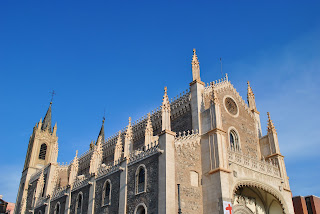Why yes, today we wandered on down to the city that is the origin of the expression “Holy Toledo!” Toledo was a holy city (no surprise there) for the Jews, but it is also where the Jews, Christians, and Muslims lived in peace for centuries. I think I saw so much that my eyes, and my legs from all the walking, are going to fall out (off for the legs). Where do I even begin? I guess with some of the history.
As mentioned previously, Toledo was an important city for the Jews, Christians, and Muslims. It was part of the Muslim empire when the Moors ruled Spain and in 1085 it was retaken by King Alfonso VI (see statue below). It was also the capital of the Visigoths in Spain, who I believe came after the Romans. El Greco, the famous painter, lived here. When it’s cloudy they say the city has “el cielo de Greco”, making reference to his dark paintings. Ok, enough history for now. But I do have one more interesting fact. All the swords used in Hollywood movies, like Lord of the Rings, come from here. Cool, huh?
Today, you can find the remnants of the time of peace (the Jews were eventually expelled, which in my mind ends this period) all over the city. There are cathedrals, monasteries, mosques, and synagogues. We got to visit many of these places.
The first was el Monasterio de San Juan. Today it is often used for weddings.
Next, we stopped by the la Sinogoga de Santa Maria la Blanca. As you can see from the name, it was a Jewish synagogue before it became a Christian church. See if you can spot the Star of David, the only reminder that it was a synagogue, in the photos below. There is an interesting story that goes along with the expulsion. When the Jews left, they only took some of their documents and their keys, because they believed they would return. These keys have been passed down for generations and families still have them today. The synagogue was built in the 12th century. ¡Que vieja! The horseshoe arches are a great example of the Muslim influence on Spanish culture.
The crowning jewel of Toledo is la Catedral Primada. There are just no words to describe it. This structure is unbelievable. Unfortunately, I couldn’t take any photos inside so I’ll have to describe some of it. The entire building is basically one room inside, like a chapel, except ten times larger in all directions. Of course, there are smaller rooms here and there on the side. There are high, vaulted ceilings, black and white checkered, marble floors, and stained glass windows. And that’s not all. There are carvings everywhere. One such carving took 17 artists and six years to create. It’s all overlaid in gold and depicts the life of Christ, from His birth to His resurrection. My favorite one, and perhaps the most amazing work of art I’ve ever seen, is at the end of the cathedral. One part surrounds a window where the light shines in onto a gold sun, which is on the other part. It’s all marble with gold mixed in. It depicts angels and Mary and Christ. You really just have to see it for yourself. My description does not even do it justice. The actual cathedral was begun in the 1200s and finished in the 1400s. Can you imagine what it felt like to finish a building that had taken 200 years to build? They must have had some party! Except, it still wasn’t finished. They continued adding more to the inside into the 1800s. But, obviously, the result was worth it. That cathedral is incredible.
I also didn’t get photos of the inside of la Mezquita del Cristo de la Luz, because we didn’t actually go inside. This mosque, built in the 10th century (that makes it 1100 years old) is the only building still preserved from before the Christian Reconquest.
Yeah, Toledo is pretty amazing, and it’s only a couple hours from Madrid. I would definitely recommend a visit if you’re ever in the area. Just don’t bring your high heels, especially if you’re a guy (that would be weird), because the whole city is up, down, up, down, and paved in cobblestone (no, that does not imply that I wore high heels. I definitely have more sense than that).





















































